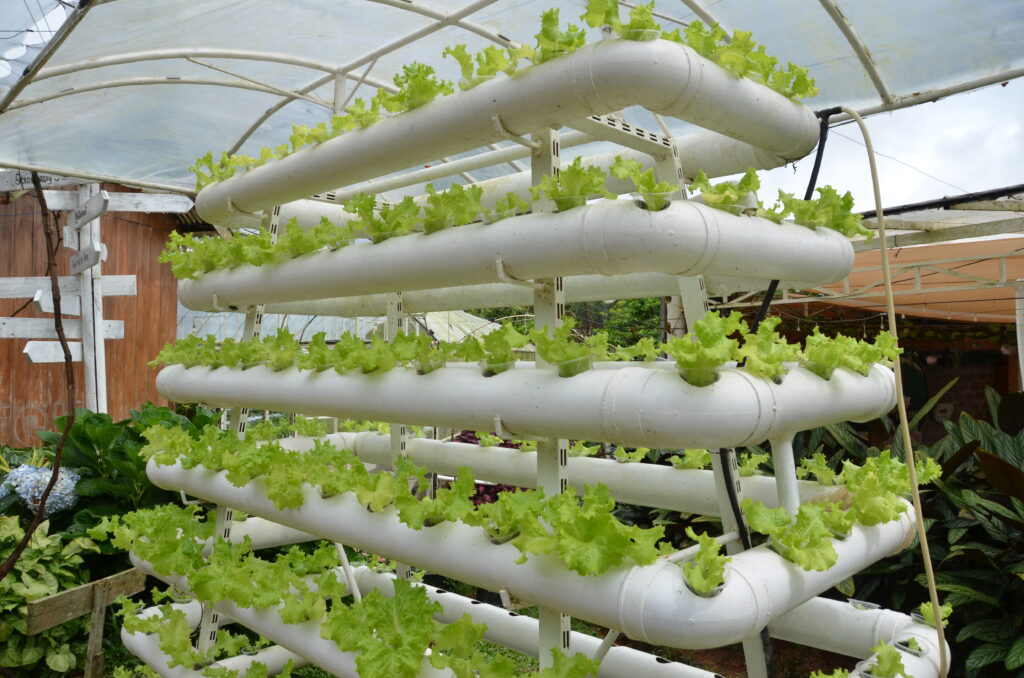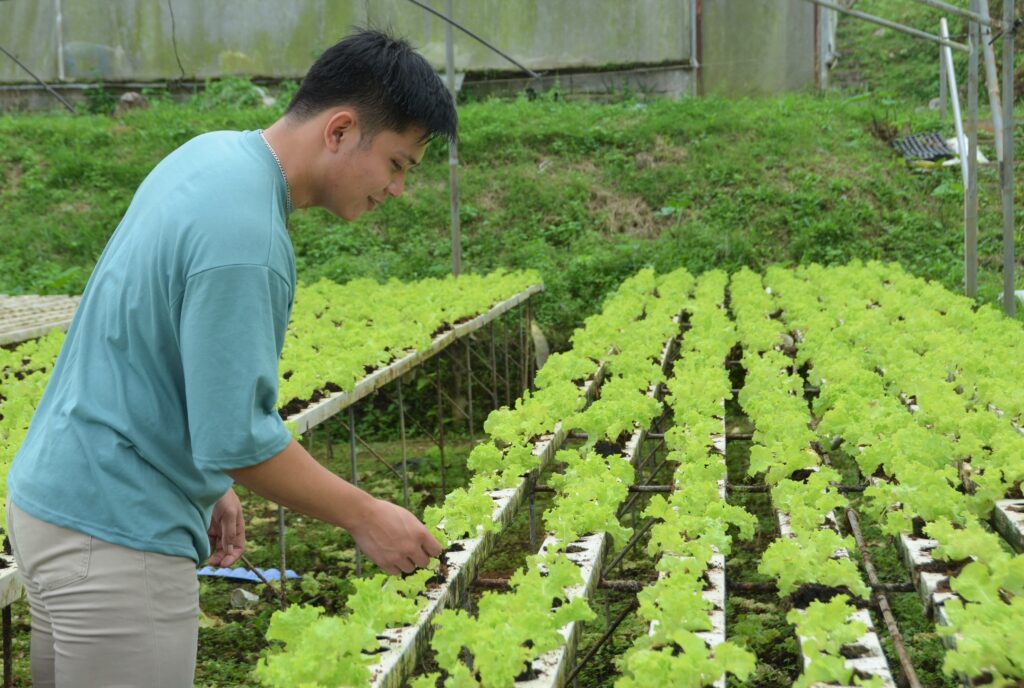Text and Photos by Henrylito D. Tacio
This one is for Robert Ripley’s Believe It or Not. If you are interested in farming but don’t have land, you can still grow crops without soil. This can be accomplished by using water. That’s what hydroponics is all about.
Hydroponic comes from two Greek words: hudor for “water” and ponos for “work”; it means “water working.”
As a technology, hydroponics is a system of growing plants using a water-based nutrient solution rather than soil and can include a growing medium such as vermiculite, coconut coir, or perlite.
In the past, hydroponic production techniques were practiced by small farmers and hobbyists but in recent years, it could be applied in commercial production, too. Experts consider hydroponics as “one of the smart technologies that can help the country ensure food security and to be climate resistant in the future.”
History records showed the first commercial hydroponics farm was set up in 1981. It was observed that the yield of vegetables was better during cool months than during the summer months.
Hydroponics farming is an upside trend in the country. According to the Philippine Hydroponics Development Corporation, around 120 hydroponic farms currently operate in the Philippines, with an annual production capacity of 800 metric tons.
In Davao City, the Eden Nature Park and Resort is practicing hydroponics. The crops grown are used mainly for its restaurant. Others are being sold in the malls.
The Yannah’s Vegetable Farming, located in Sto. Niño Compound in Matina Crossing, is also growing lettuce, onion, basil and strawberry hydroponically.
One of the main features of hydroponics is fertigation, a combination of fertilization and irrigation. Nutrients and soluble fertilizers like phosphorus, nitrogen, and calcium, are mixed into water. These are fed through dripping hoses.
In some hydroponics systems, a growing medium is used to support the plant roots and allow for more effective water absorption to the root structure.
The US National Park Service cites the following advantages of hydroponics: enhanced plant yields (as the crops are densely spaced together), less water utilization (as much as 10 times less water), locally-grown (allow to grow almost anywhere), and less space (taking up a small amount of space).
“Hydroponics system is becoming popular among farmers because it is a low-cost, high-yield method of farming that doesn’t rely on pesticides or fertilizers,” commented Randy Gatuangco, a computer technician who practices hydroponics in his home.
It’s easy to see the advantages of hydroponics. But there are some disadvantages, too. The Seattle-based website, trees.com, shares the following drawbacks:
Expensive to set up: Compared to a traditional garden, a hydroponics system is more expensive to build. Costs range depending upon the type and size of the system, and whether the materials used are prefabricated or built with individual components.
Vulnerable to power outages: Hydroponics systems depend on electricity to power the different components such as grow lights, water pumps, aerators, and fans, among others. As such, a power outage will affect the entire system.
Require constant monitoring and maintenance: To maintain a carefully controlled growing environment, all system components need constant vigilance – lights, temperature, and many aspects of the nutrient solution such as pH and electrical conductivity. The nutrient solution also needs to be flushed and replaced regularly, and the system parts cleaned often to prevent build-up and clogging.
Waterborne diseases: As the crops are grown in the water instead of soil, waterborne diseases are considerably higher. With the water circulating continuously through the system, infections can spread quickly throughout the growing system as a whole.
Problems affect plants quicker: Soil protects the roots from extreme temperature changes, slows diseases and pests from attacking, and regularly releases and absorbs nutrients. Without soil as a buffer, plants grown in hydroponics systems react negatively to problems like nutrient deficiencies and disease much quicker.
Almost any crop can be grown hydroponically but the most common ones are leaf lettuce, tomatoes, sweet peppers, green beans, cucumbers, strawberries, celery and some herbs. These hydroponically-grown vegetables can be just as nutritious as those grown in soil.
“The truth is that crops grown in a local hydroponic vertical farm are, in fact, better in taste and safer than the food you might find farmed otherwise,” wrote Arturo Brosas, author of “Hydroponics Farming in the Philippines.”
Lettuce is the most-often grown crop in hydroponics as it is popular in restaurants, hotels, and fast foods.
In Iloilo, a locally developed smart greenhouse hydroponics is being introduced. The Iloilo Science and Technology University (ISATU), which initiated the project, applies the Internet of Things (IoT) technologies to automate the monitoring and control of growth parameters for lettuce grown in a nutrient-film-technique (NFT) hydroponics system.
The ISATU project, led by Dr. Renerio S. Mucas, developed components of this technology including the hardware and firmware and installed and tested them at Ephrathah Farms, Inc. in Badiangan, Iloilo City.
“I am beyond satisfied with the system now,” Engr. Ed Roderick V. Canuto, farm manager of Ephrathah Farms, Inc, commented.
In the past, he visited his farm on early Sunday mornings to handle the tedious work that his farm attendant was doing on weekdays. He checked the greenhouse, even in the middle of the night, because the hydroponics monitoring and control system is remotely accessible by computer laptop or mobile phone.
Engr. Canuto now stops doing so. He doesn’t need to visit the farm to turn on the water-cooling system since all features and information are easily controlled and accessible.
“During the first run of our production under the automated system, I was surprised to have the best production I ever had,” he recalled. “I had 250 grams per lettuce head. I used to be happy with only 60 grams per head of lettuce.
“Monitoring the acidity or pH and other grown parameters and dosing the right amount of nutrients at the right time gave us consistent production yield,” he added.
Before the automated system, Ephrathah Farms manually recorded the microclimate and agronomic parameters essential for lettuce’ growth, which had inconsistent results leading to variable production yields.
It has been observed that the IoT smart greenhouse minimized labor and made it less tedious for Engr. Canuto and his attendant.
During the terminal review, Dr. Mucas said the smart greenhouse hydroponics is equipped with sensors and communication technologies that automatically captures data on essential parameters such as temperature, acidity, electrical conductivity, and water flow.
The collected data goes through an IoT platform for monitoring, analysis, and control. Aside from monitoring from a personal computer, use of Android App enables the farm manager to remotely monitor the system’s status or control specific actuators for water flow, water-cooling, and fertigation.
More importantly, the automated system of hydroponics uses low energy requirements and is run and powered by solar energy. “Generally, it helps improve efficiency in use of resources and nutrients, while optimizing yield gains,” Dr. Mucas said. – ###



